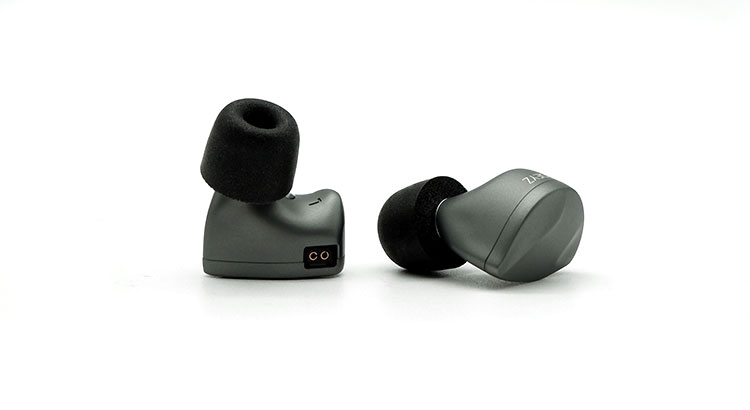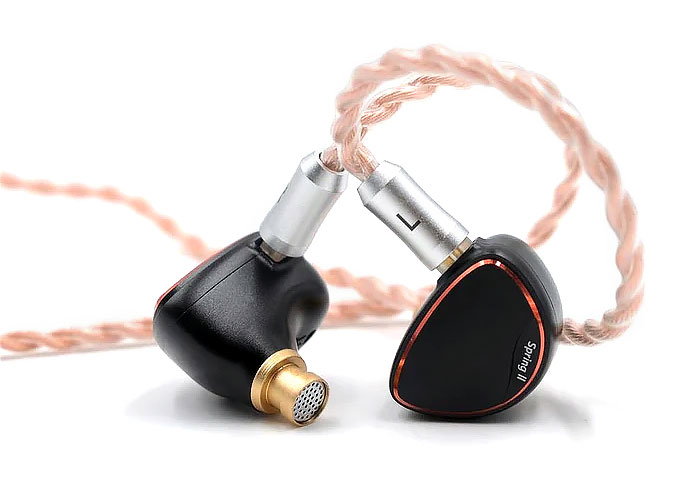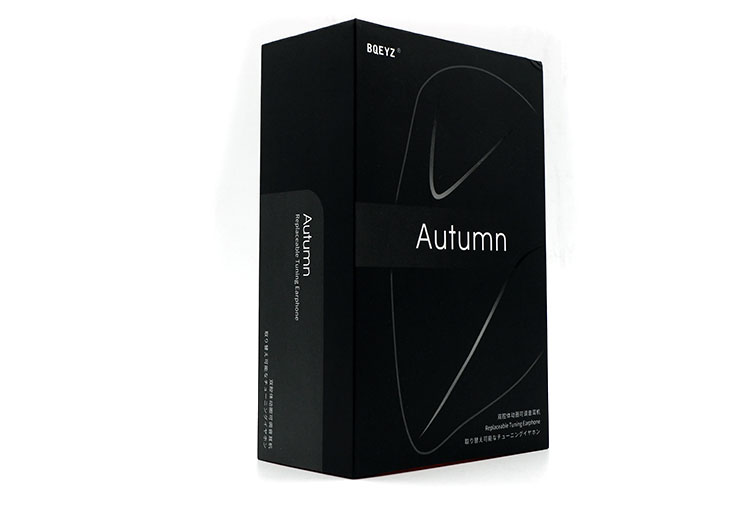Select Comparisons
Mangird MT4
$199
Technical
While the 2 IEMs have the same price point, the MT4 has 4 drivers, 1 German-made dynamic driver which is complemented by a dual BA Sonion driver for the midrange, and a Knowles BA driver for the treble.
Although the MT4 has a higher driver compliment, it doesn’t automatically put it at an advantage, as more drivers also mean going through a more complicated crossover circuit.
Aside from the drivers, the MT4 also has specially designed resin shells that tune the IEM based on user feedback from their previous products. Interestingly, both IEMs share a similar cable type, with the MT4 having a stock 6N silver-coated copper cable.
Design
When looking at the 2 IEMs side by side, the biggest difference that you would notice is that the MT4 is not as heavy. This is mainly due to its resin shells, and despite having more drivers inside, the MT4 comes in much lighter, which surprisingly makes them a bit harder to manage because they don’t stay as securely in my ears.
Both IEMs also use the 0.78mm 2-pin connection, and they also both have an ear hook design, so they are equally comfortable. The biggest difference is that the MT4 has a thicker cable, but ultimately, both IEMs are equally comfortable and manage to fit in the carrying case.
Performance
With foam tips on the Autumns, the bass performance of the 2 IEMs is comparable, having the same amount of mid-bass quantity. When it comes to the sub-bass extension though, the MT4 is noticeably more extended and flatter comparatively.
When listening to drum-heavy tracks, the MT4 has a more rounded bass response, giving the drums a more natural timbre and attack while having more impact. Both IEMs are equally detailed though, so the textures of drums, bass guitars, and even string instruments are similarly fleshed out.
The MT4 has a more forward vocal range, giving vocalists like Josh Groban more power and grunt behind their performance. Interestingly, there is also a more euphonic and sweeter character to the vocals on the MT4, while presenting a comparatively darker timbre.
Plucking on the guitars has a more full-bodied presentation on the MT4, while the details and textures of the strings on the guitars are equally fleshed out. When listening to piano pieces like the ones played by Yiruma, however, it has comparatively less sweetness and sparkle on the MT4.
Having a more subdued treble response, the MT4’s lower treble range is comparatively less excitable making cymbal hits sound less apparent. However, it still manages to present cymbals with more bite, while horns have a more natural sense of airiness and space behind each note.
Although the MT4 has a noticeably wider soundstage presentation, this isn’t always a good thing, as this comes with a more dispersed imaging presentation. This also leads to the MT4 casting larger images within the soundstage, that may end up overlapping with each other, making it more difficult to differentiate one from the other.
BQEYZ Spring 2
$170
Technical
With Spring 2, BQEYZ implemented a tribrid system, using a 13mm dynamic driver, a single-BA driver, and a piezoelectric driver which is more commonly found in microphones these days.
Aside from the tribrid technology, the cable that’s used with the Spring 2 is also quite different since BQEYZ opted to use a pure copper cable, instead of silver-coated copper cables.
The combination of these technologies leads me to believe that the 2 IEMs take the strengths of their respective technologies and implement them to create a version of the BQEYZ house sound with it.
Design
While the technologies that are used in the 2 IEMs are quite different, they look quite similar when you put them side by side, particularly because both IEMs use anodized aluminum shells.
However, the Spring’s shells have accents that make them more conspicuous. Also, both IEMs have a similar structure, both having a metal nozzle with a lip that will ensure that the ear tips stay in place.
Clearly absent from the Spring 2 though is the additional tuning magnets, so there won’t be any holes for tweaking the tonal balance of this IEM.
Despite the cable on the Spring 2 being made of a different material, the cable feels surprisingly similar. So, they both have the same 0.78mm 2-pin termination, and an ear hook design, as well as a soft PVC coating that won’t end up being microphonic even when you move your head around when wearing the IEMs.
Performance
Coming from the same company leads me to expect that the 2 IEMs would have a lot in common, and it turns out that the treble region of both IEMs is very similar.
With the treble being forward and excitable while having a natural knack for treble detail retrieval. Both IEMs also have a good amount of treble extension, while staying away from having an artificially elevated upper treble response.
Spring 2 has an even more pushed-back vocal presentation forcing vocalists further into the background. Midrange instruments, on the other hand, have an even brighter timbre with the Spring 2 making pianos and guitars sound thinner but more singular. Interestingly, when there are claps in the track, the Spring 2 sounds more like a splat and an actual snappy clap.
The bass on the Spring 2 isn’t as forward sounding but still quite tasteful. This ensures that it would be even harder for the bass on the Spring 2 to bleed into the rest of the frequency spectrum. Also, the bass on the Spring 2 is more extended, allowing the sub-bass rumble to be more apparent.
Having a piezo driver on the Spring 2 seems to have its benefits, as it allows the Spring 2 to have a wider and more extended soundstage presentation. However, the comparative lack of resolution makes it harder for Spring 2 to have the same level of image separation and depth when presenting images within the soundscape.
Tanchjim Hana 2021
$179.99
Technical
Both IEMs use a single dynamic driver inside their shells. However, the one in the Hana 2021 uses an LCP, (Liquid Crystal Polymer), diaphragm, and a DMT 3rd magnetic structure that produces high amounts of magnetic flux to ensure a more dynamic response.
Also, the Hana 2021 has a lower impedance at 32Ω at the same sensitivity level, which translates to the Hana being an easier load to drive to louder volumes. In reality, though, both IEMs can easily be driven off of any source, so it’s not something I would worry too much about.

Design
I initially thought that they would have about the same weight, however, the Hana ended up being the heavier IEM, since it’s made of 316-grade Stainless steel. The shells on the Hana are more polished though since each shell has porcelain inlays while the sides are coated with metallic paint.
With the added weight on the Hana, they end up being a bit more cumbersome when worn, since they have more of a tendency to fall off my ears. However, both IEMs have an ear hook style cable, which helps make them stable, with the Hana being less stable relatively.
Looking at the cables, the stock cable that comes with the Hana is much thinner, while all the strands aren’t visible, since they are all housed inside the plastic tube. This makes the Hana easier to manage, particularly when it’s in the carrying case. Surprisingly, this also makes the cable more rigid, making the one on the Hana comparatively more microphonic.
Performance
The Hana 2021 has the more extended sub-bass region of the two IEMs but both IEMs have a similar amount of mid-bass bloom. However, the one on the Hana 2021 is less controlled, which consequently results in having a harder time presenting accurate textures with drum hits and bass guitars.
In terms of the vocal range, the Hana 2021 has a more traditional dynamic driver sound since it presents a more powerful and euphonic vocal presentation.
Similarly, the Hana 2021 has more power behind midrange instruments, which translates to having a more full-bodied and percussive delivery of piano tracks. Both IEMs have a similar amount of airiness though, so the breathiness of vocals is similar.
The Hana has a more subdued lower treble response, making it less excitable. However, it presents horns more naturally, as there is more body and airiness with each note. The more subdued treble response on the Hana comes at the cost of having less bite and edge from each cymbal hit.
The overall detail retrieval of both IEMs is similar, which means they both also have a similar level of accuracy when it comes to placement and separation of the images within the soundscape.
The width and breadth of the soundstage tend to be comparatively wider on the Hana 2021, which allows it to have a more dispersed and distributed imaging presentation.
Our Verdict
The Autumn aesthetic will immediately give the user a sense of a polished product in a good-looking package. It even has tuning filters that will add allow IEMs to be versatile enough to adapt to different tastes through fine-tuning. However, I would have wanted to see a pair of foam tips inside the package to add more coarse adjustment options to the sonic performance.
Sonically, BQEYZ packed the Autumn with technical capabilities that allow it to maintain its composure even with more complicated passages. It creates an overall engaging and energetic presentation, which makes for an enjoyable listen for those who would prefer a more controlled and V-shaped tonal balance with a more immersive listening experience.
BQEYZ Autumn Specifications
- Dynamic Driver 13mm
- Impedance 46Ω
- Sensitivity 110 dB
- Frequency 7-40KHz
- Cable Length 2m
- Connector Type 78mm-2 Pin
- Plug Type 5/3.5/4.4mm available




